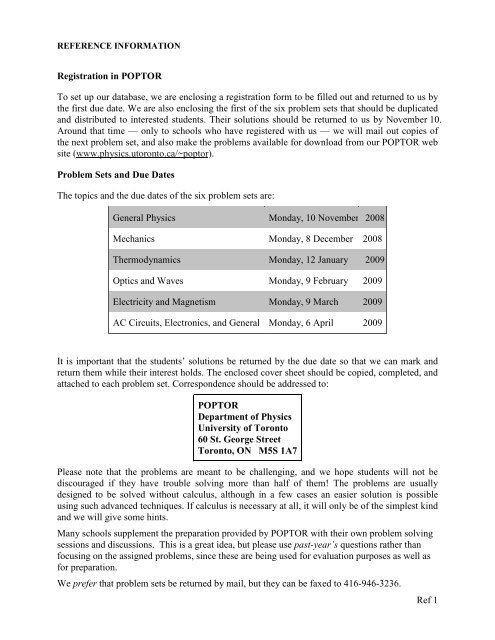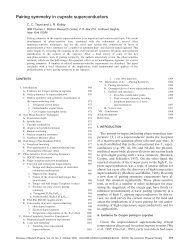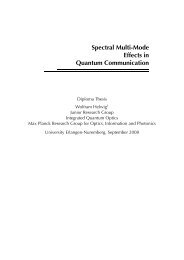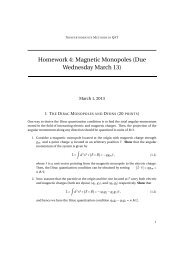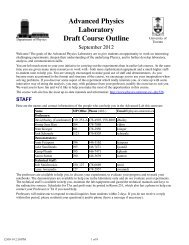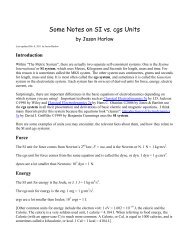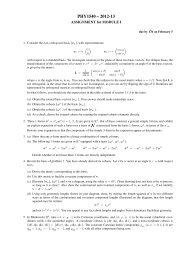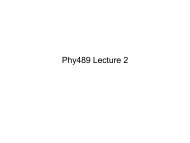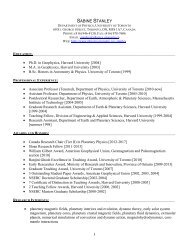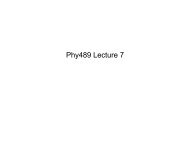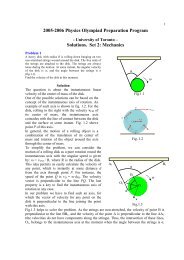Ref 1 Registration in POPTOR - Department of Physics - University ...
Ref 1 Registration in POPTOR - Department of Physics - University ...
Ref 1 Registration in POPTOR - Department of Physics - University ...
Create successful ePaper yourself
Turn your PDF publications into a flip-book with our unique Google optimized e-Paper software.
REFERENCE INFORMATION<br />
<strong>Registration</strong> <strong>in</strong> <strong>POPTOR</strong><br />
To set up our database, we are enclos<strong>in</strong>g a registration form to be filled out and returned to us by<br />
the first due date. We are also enclos<strong>in</strong>g the first <strong>of</strong> the six problem sets that should be duplicated<br />
and distributed to <strong>in</strong>terested students. Their solutions should be returned to us by November 10.<br />
Around that time — only to schools who have registered with us — we will mail out copies <strong>of</strong><br />
the next problem set, and also make the problems available for download from our <strong>POPTOR</strong> web<br />
site (www.physics.utoronto.ca/~poptor).<br />
Problem Sets and Due Dates<br />
The topics and the due dates <strong>of</strong> the six problem sets are:<br />
General <strong>Physics</strong> Monday, 10 November 2008<br />
Mechanics Monday, 8 December 2008<br />
Thermodynamics Monday, 12 January 2009<br />
Optics and Waves Monday, 9 February 2009<br />
Electricity and Magnetism Monday, 9 March 2009<br />
AC Circuits, Electronics, and General Monday, 6 April 2009<br />
It is important that the students’ solutions be returned by the due date so that we can mark and<br />
return them while their <strong>in</strong>terest holds. The enclosed cover sheet should be copied, completed, and<br />
attached to each problem set. Correspondence should be addressed to:<br />
<strong>POPTOR</strong><br />
<strong>Department</strong> <strong>of</strong> <strong>Physics</strong><br />
<strong>University</strong> <strong>of</strong> Toronto<br />
60 St. George Street<br />
Toronto, ON M5S 1A7<br />
Please note that the problems are meant to be challeng<strong>in</strong>g, and we hope students will not be<br />
discouraged if they have trouble solv<strong>in</strong>g more than half <strong>of</strong> them! The problems are usually<br />
designed to be solved without calculus, although <strong>in</strong> a few cases an easier solution is possible<br />
us<strong>in</strong>g such advanced techniques. If calculus is necessary at all, it will only be <strong>of</strong> the simplest k<strong>in</strong>d<br />
and we will give some h<strong>in</strong>ts.<br />
Many schools supplement the preparation provided by <strong>POPTOR</strong> with their own problem solv<strong>in</strong>g<br />
sessions and discussions. This is a great idea, but please use past-year’s questions rather than<br />
focus<strong>in</strong>g on the assigned problems, s<strong>in</strong>ce these are be<strong>in</strong>g used for evaluation purposes as well as<br />
for preparation.<br />
We prefer that problem sets be returned by mail, but they can be faxed to 416-946-3236.<br />
<strong>Ref</strong> 1
REFERENCE INFORMATION<br />
Other Resources<br />
<strong>POPTOR</strong> homepage<br />
We ma<strong>in</strong>ta<strong>in</strong> the <strong>POPTOR</strong> website on the Internet:<br />
www.physics.utoronto.ca/~poptor<br />
This site provides up-to-date news about <strong>POPTOR</strong> <strong>in</strong>clud<strong>in</strong>g any corrections, question sets for<br />
this year (and solutions as they become available) <strong>in</strong> the convenient Adobe PDF format (suited<br />
for view<strong>in</strong>g or pr<strong>in</strong>t<strong>in</strong>g on any computer), photos and illustrations that show how the questions<br />
connect with every-day or other-world situations, reviewed l<strong>in</strong>ks to useful or <strong>in</strong>terest<strong>in</strong>g science<br />
web-pages, other resources and helpful textbooks, and previous years’ problem sets and solutions.<br />
Comments on what you f<strong>in</strong>d useful (and otherwise) are much appreciated!<br />
Some useful textbooks:<br />
We encourage students to search out additional <strong>in</strong>formation on the problems by consult<strong>in</strong>g<br />
reference sources. The best references are any good, modern first year college physics texts, such<br />
as these currently used at the <strong>University</strong> <strong>of</strong> Toronto:<br />
Fundamentals <strong>of</strong> <strong>Physics</strong>,<br />
David Halliday, Robert Resnick and Jearl Walker (J. Wiley & Sons)<br />
<strong>Physics</strong>,<br />
John D. Cutnell and Kenneth W. Johnson (J. Wiley & Sons)<br />
<strong>Physics</strong> for Scientists and Eng<strong>in</strong>eers, with Modern <strong>Physics</strong>,<br />
Richard Wolfson and Jay M. Pasach<strong>of</strong>f (Addison-Wesley)<br />
<strong>Physics</strong> for Scientists and Eng<strong>in</strong>eers,<br />
Randall D. Knight (Pearson/Addison-Wesley)<br />
Additional collections <strong>of</strong> solved problems are given <strong>in</strong>:<br />
The <strong>Physics</strong> Problem Solver,<br />
James Ogden (Research and Education Foundation)<br />
3,000 Solved Problems <strong>in</strong> <strong>Physics</strong> (Schaum's Solved Problems Series),<br />
Alv<strong>in</strong> Halpern (McGraw-Hill)<br />
Schaum's Outl<strong>in</strong>e <strong>of</strong> Applied <strong>Physics</strong>,<br />
Arthur Beiser (McGraw-Hill)<br />
Supplementary <strong>in</strong>formation for students’ tra<strong>in</strong><strong>in</strong>g is provided on the <strong>POPTOR</strong> website<br />
<strong>Ref</strong> 2


